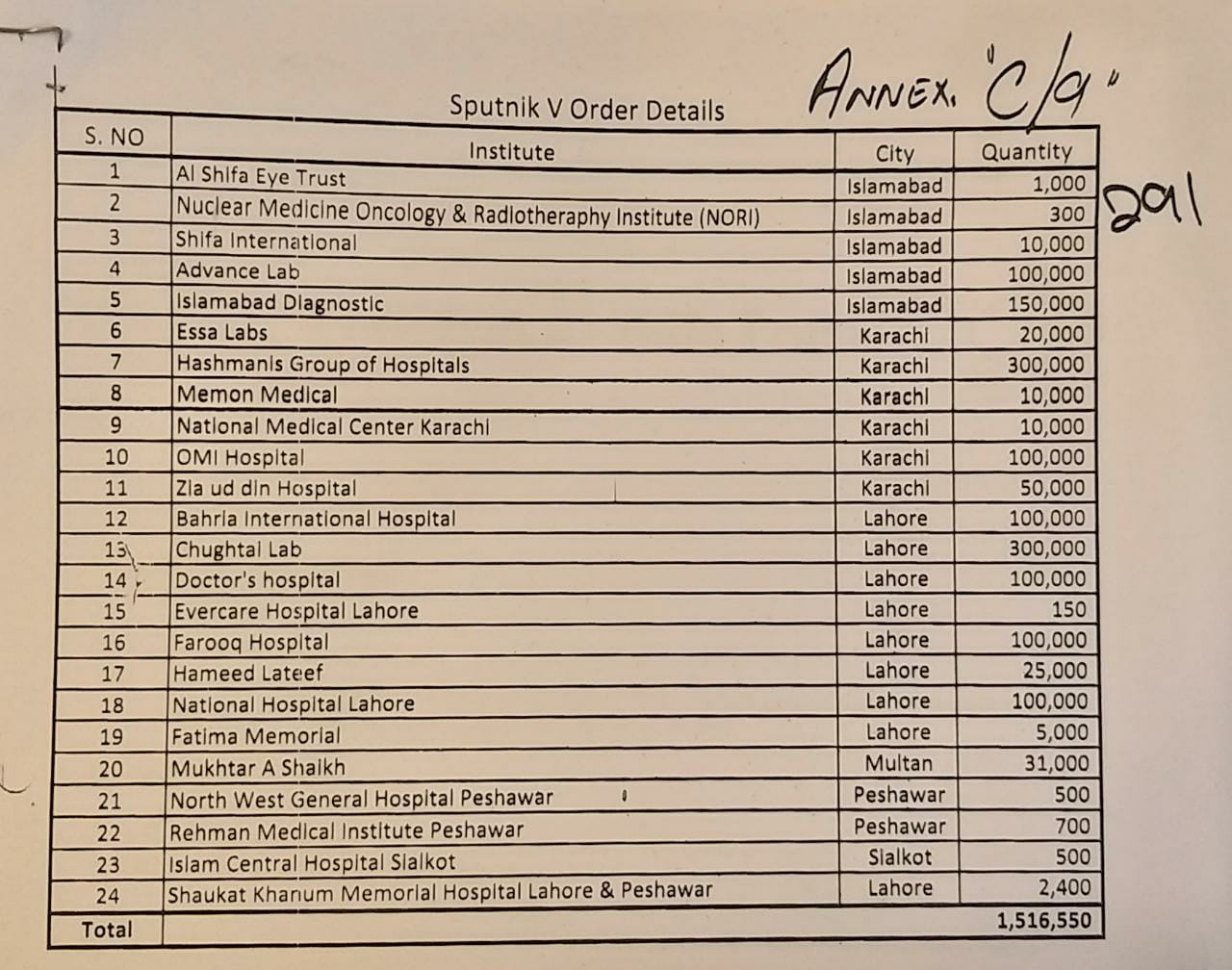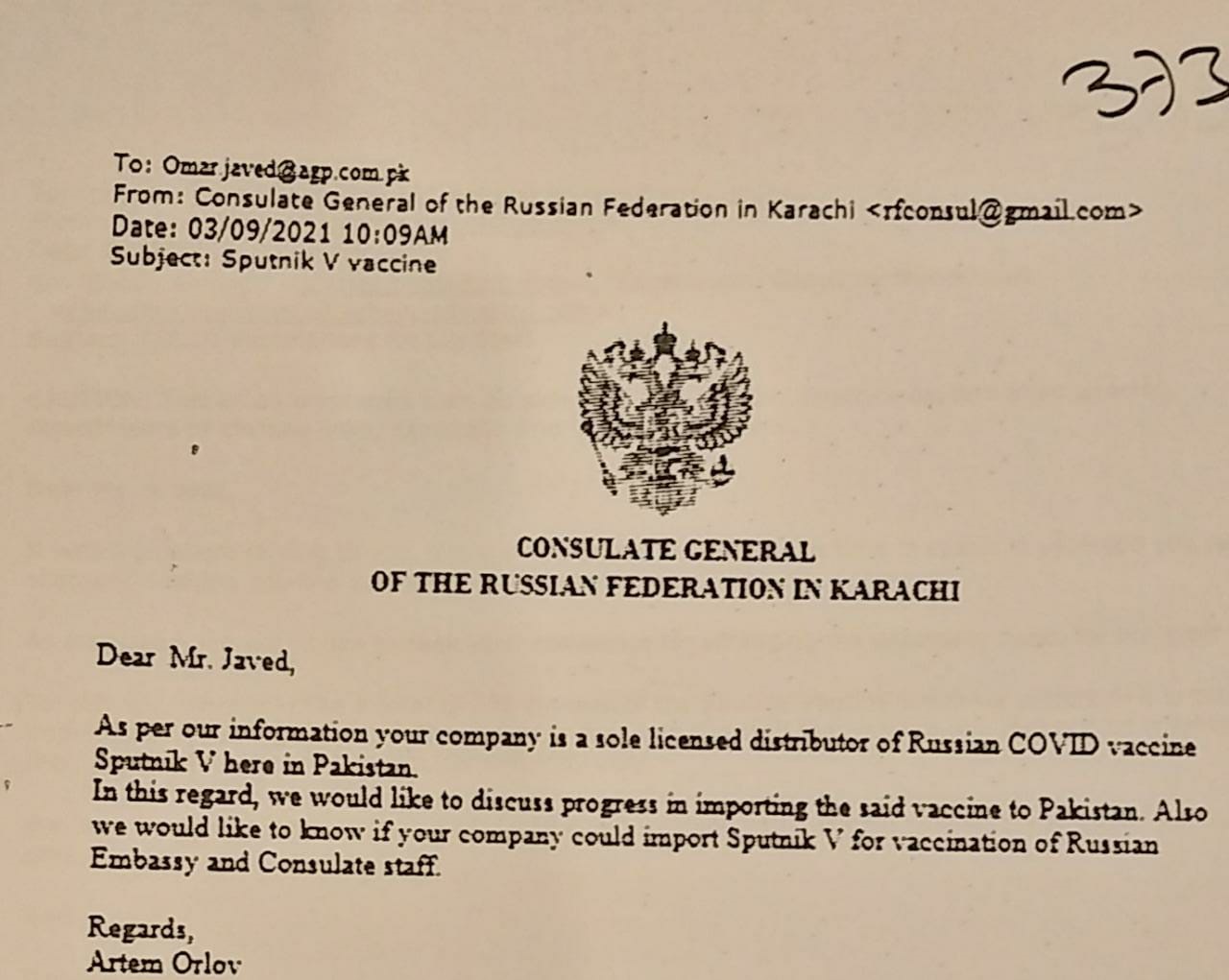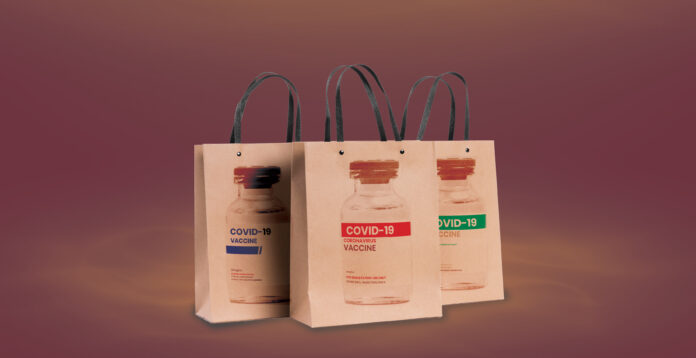On March 17th this year, AGP Limited received a shipment of 50,000 full doses of the Russian Sputnik-V vaccine from the United Arab Emirates (UAE). The Russian vaccines had been privately bought by the Pakistani pharmaceutical company from the private office of a Prince of the UAE Royal Family, and at a rate much higher than at which the same vaccine was being sold to some other countries. The purpose was for AGP to privately vaccinate people willing and able to pay for it, while the government would use COVAX consignments and vaccines they procured themselves to inoculate the rest of the population.
What followed the arrival of the Sputnik-V vaccines from the UAE was a process nearly as chaotic and confused as the chain of events that led to AGP securing the imported vaccines. First, there was the complex maze of international parties and middlemen representing the Russian vaccine developer. Then, when the shipment finally arrived, the Pakistan government had no idea what to price it at, but it had already given permission to AGP Limited to import the vaccine. So when AGP set a price and the government disagreed with that price, the dogs of war were let loose.
Court cases raged, AGP threatened to sell the vaccines to some other country, and the government stepped in and stopped them from administering the vaccines until AGP took the government to court as well. All this while, the country’s urban upper-middle class waited with bated breaths to see if they would manage to get the vaccine.
Today, after all this, the Sputnik-V vaccine is not available in Pakistan either privately or through government channels because a reasonable compromise on price has not been achieved till the filing of this report. Despite this, the demand for private vaccination in Pakistan remains high. This entire murky, failed experiment with private vaccination has raised questions about how the vaccine was procured,, why the government allowed the vaccine to be imported before they established a base price with the importer, and most importantly, why the UAE Royal Family (not the UAE government) got involved with the sale of Covid-19 vaccines in Pakistan.
And while this story focuses on how AGP imported the Sputnik-V vaccine and only managed to ever administer 50000 doses, it will also look at how and why private for profit vaccination works, and whether after this initial experiment with it, it should be given another shot. Profit investigates.
The upper-middle class wants the jab
One has to ask the question, what in the world is the point of private vaccination when the government is offering to one by one vaccinate everyone for free? The only problem is that the government wants to prioritize people like healthcare workers and the elderly that need the vaccine more. Meanwhile people mostly belonging to the upper middle class whose lives of leisure and socializing have been interrupted by the pandemic want a solution and they did not mind paying to cut in line.

Already, even in the free vaccinations that the government has conducted up until now, it has been people belonging to a certain class that have mostly gotten vaccinated. In an observation made on June 1st, LUMS Assistant Professor and columnist Umair Javed in a tweet said “Vaccine hesitancy/misinformation is so pervasive here in Pakistan, and uptake increasingly appears to be stratified by class. Moving the needle on this is going to be such a tough task for the government. Most people I know (professionally/socially) have received at least one shot. Many here on twitter too. Yet total vaccines administered are only ~8 million (in an adult population of over 100 million). Hope this picks up.”
In fact, this seems to be how it is in the developing world. Compare Pakistan to the United Kingdom and the United States, for example, which are the two countries with the highest inoculation rates in the world today. The UK recently opened up registrations for the 30-32 age bracket after more than 50% of their population had received at least one dose of the vaccine. Pakistan opened the registration for the 30+ demographic after only 2% of the population had received at least one dose. While Pakistan has a much smaller population of people that are above 50 years than the UK and the US, the move by the government to open registration up to anyone indicates low interest.
The trend this points towards is that in Pakistan, it is generally the urban elite that have been lining up to get vaccinated. This was perhaps most on display in the way that people registered for the Sputnik-V private vaccine. This started, as all chaotic things worth their salt do, with a Whatsapp forward. A message containing a google form for registration started making the rounds, and despite looking seedy and whatever the opposite of officious is, it was promptly shared beyond count. Without much concern, people filled in their names and ID card numbers and waited for confirmation.
Within hours, the spots had all gone. Similar messages spread throughout Karachi and Islamabad as well. The price that was being conveyed was Rs 12,000 for both doses. Desperate to have some sense of normalcy back, Pakistan’s urban upper-middle class was ready to pay that amount of money for some relative safety. It is worth mentioning that while vaccine uptake has improved significantly now with the government making the vaccination process much more efficient, back in March, Pakistan’s vaccine uptake had been the slowest in the region by a long way. Just over 70,000 frontline medical workers had been inoculated with the 500,000 doses of the Sinopharm vaccine that had arrived from China, and the vaccination registration for the at-risk group of those aged 65 and above was only just starting.
It was in this environment that mostly young and mostly upper-class people were looking for ways to get vaccinated as soon as possible. Seeing this, a number of companies including AGP decided it would be worth getting into the business of importing and providing private vaccines. However, it was only AGP that ended up managing to import vaccines and sell them to the public. This permission granted by the government was conditional. Because the vaccines had never been sold privately before, the government had no idea how to cap the price, and told AGP they could import the vaccine and that the government would tell them the ceiling price later.
This is where the trouble started, because the government seems to have been unaware of just how many middle-men and hoops AGP Limited was going through to get the Sputnik-V vaccine here, and that people were also more than willing to pay a lot of money to get their shots.
On paper, in a country like Pakistan, it makes a lot of sense for there to be privately available vaccines. The government needs to make sure that people across class categories are getting vaccinated, and to do that, other than awareness they are going to have to provide incentives as well. Private companies are already doing this, while the Sindh government is making it mandatory for everyone to get vaccinated. So if the government were to focus on segments other than the urban upper middle class and above getting vaccinated, those that could afford to pay for the vaccine would do that, especially since a lot of people would prefer to get vaccinated by the Russian Sputnik-V vaccine than the mostly Chinese vaccines otherwise available in Pakistan, because of the incorrect perception that the Chinese vaccines might not be as efficient or safe. Moreover, there is also some hesitancy amongst locals to get Astra Zeneca due to the reported clotting side effects. In a nutshell, the privileged lot in Pakistan decided to go vaccine shopping to pick out their preferred one. But at the same time, a balance needed to be struck to make sure that companies and individuals were not heedlessly profiteering.
The UAE connection
You would expect that AGP Limited would import the Russian Sputnik-V vaccine from, well, the Russians. Instead, they struck a deal with the private office of Sheikh Ahmed Dalmook Al Maktoum. The agreement was signed on the 10th of March and documents obtained by Profit show that AGP was to import 1 million doses of Sputnik V at $45 per unit on cost and freight basis. This excludes taxes and duties which were to be borne by AGP. This makes the total price on cost and freight basis to be $45,000,000. The deal also stated that AGP could pay partially for 1 million vaccines and will receive their order within a specified time period.

The reason AGP had to go to the Sheikh, according to them, was that the Russian developers of the vaccine had given the rights to sell and distribute Sputnik V in certain countries and territories, which included Pakistan. Now, it is important to note that AGP here is not dealing with the UAE or the Dubai government. They are being provided the vaccine by Sheikh Ahmed Dalmook Al Maktoum, the grandson of the late Sheikh Saeed bin Maktoum bin Hasher Al Maktoum, who was the longest reigning ruler of Dubai up until his death in 1958. Sheikh Al Maktoum, a nephew of the Emir of Dubai, currently runs and operates a portfolio of privately held group of companies that focus mainly on Infrastructure Development, Energy Projects, LNG Terminal Development, Commodity & Oil Trading, Water Desalination, Water Recirculation as well as Education and Agricultural Projects. He has wide interests in Africa, South America, and South Asia.
The involvement of the UAE Royal Family in this entire affair has been strange and shrouded in mystery. The Sputnik-V vaccine was developed by the Gamaleya National Center of Epidemiology and Microbiology of the Ministry of Health of Russia. This was done through funding by the Russian Direct Investment Fund (RDIF). The RDIF is a sovereign wealth fund by the Russian Federation and has invested in the mass production of the vaccine by its portfolio companies in order to distribute it across the globe.
“Human Vaccine” is a limited Liability company that is under the umbrella of the Joint Stock Company “Management Company of RDIF”. Human Vaccine has authorized Aurugulf Health Investment, Abu Dhabi to sell and distribute the vaccine in several countries which include Pakistan.
And it doesn’t end here. Aurugulf has then appointed the private office of His Highness Sheikh Ahmed Dalmook Al Maktoom of Dubai to develop, distribute, and market the vaccine in Pakistan. The private office has then appointed AGP to register, market, distribute and sell the vaccine in Pakistan. Naturally, this begs the question of why the Pakistani government made no attempt to procure directly from the Russians? In fact, even the recent announcement that the Pakistan Army is to procure Sputnik V also states that they are to get their vaccines from the UAE.
The only thing that procuring vaccines through these elaborate connections of middlemen does is raise prices, causing unnecessary strain on developing countries. These middlemen too are doing little else other than trying to make a quick buck out of people’s desperation to get vaccinated.
A source claims that the UAE royal family has invested in the development/ production of Sputnik V and therefore got distribution rights for it.

In fact, in Pakistan’s case, the source has further alleged that the UAE royal family has made private equity investment in AGP. While this cannot be proven through the shareholding list, if true, it would mean that the private office of Sheikh Al Maktoum would first make a profit selling the vaccine to AGP, and then again when AGP sells the vaccine to people in Pakistan. However this does not mean that there is no chance of an investment. It can be made through an investment in a company that has further invested in AGP. When asked, AGP denied any knowledge of it.
The reason such an investment (if any) needs to be disclosed is because it leads to the thought of transfer pricing. Transfer pricing would be likely in that scenario considering AGP already knew it would only be allowed 40% above the landed cost.
However, it is also important to note that Aurugulf is an authorized vaccine distributor for various countries and is also a seller to the Pakistan Army. Therefore, the notion of transfer pricing is questionable. Moreover, the reason these distributors are charging $45 for the vaccine could probably be attributed to the fact that they are accounting for their costs. This could include the investment cost, if they have funded the research of the vaccine through RDIF, or the cost incurred to get distribution rights.
It was through this murky chain of confusing connections that AGP Limited finally managed to strike a deal, a couple of days after which the Pakistan government also approved the Sputnik-V vaccine for emergency use. The problem was the price. As per documents available with Profit, AGP was initially told that the price of the vaccine was to be $30 landed cost, which would be around Rs 5000. However, AGP claims that this was the price they were quoted back in January when Sputnik V had not been approved in many countries and it was not in high demand. But within the next few months it was registered in more than 50 countries, which meant that its price suddenly went up. And according to AGP, the landed cost of the vaccine ended up being $45, or Rs 6900.
Now, despite this $45 landing price, AGP Limited announced that it was going to be charging $83.95 or PKR 13,600 for the vaccine. From the very outset the government indicated that the price was too high, so AGP Limited went ahead and revised their prices, dropping them down to Rs 12,226. This was also met with disapproval from the government which wanted the vaccine to sell at Rs 8449, or $54.
The pricing war
Here is what we know up until now. Back in March, the government was only vaccinating people on a priority basis, but there was a significant enough demand from the upper middle class segment of society that AGP imported an initial 50000 doses of the Russian Sputnik-V vaccine from the private office of a UAE Prince. The doses arrived and people signed up for them, but the government and AGP disagreed on what these doses should be priced at.
The first thing to happen was that Transparency International wrote to the prime minister stating that the vaccine was too expensive, and that it should be priced around $20. Now, it has already been established that the landing price of the vaccine in Pakistan was at least $45, so the estimate by Transparency International was low, but once the figure of $20 was out there, it quickly entered the public’s imagination that AGP was selling the vaccine for 300 times the price it was in other countries.

But even if the landed price in Pakistan was $45, the contention became that AGP was still selling the vaccine for too much. The government wanted to sell at Rs 8449, or $54. To this, AGP said that they would be unable to make any money. Regardless of whether it would be profitable for them or not, it is important to note that drug companies are allowed 40% margin on life saving drugs and $54 would mean a 20% margin for AGP.
According to AGP Ltd., the vaccine is priced higher considering the supply chain and distribution constraints. While most vaccines have to be stored at 2-8 degrees Celsius, the Sputnik vaccine needs to be stored and transported at -18 degrees Celsius and that comes with a higher cost. The product is frozen and then is later converted for usage.
An official from AGP said that the vaccine is specially packaged in dry ice which keeps it in required temperatures for 72 hours. There are also data loggers in the package that monitor the drug from the manufacturer to the destination. The official further explained that on top of the landed cost of the drug ($45 or roughly Rs 6,900), there is a 40% margin build up on the drug that is distributed among the storage facilities, related taxes, logistics and distribution and the margin for the importer. On top of the 40%, 15% of the margin goes to healthcare facilities, like hospitals that administer the vaccine, whereas 6-7% is taken by the government in the form of taxes.
Therefore, according to the company, the only way to make the vaccine commercially feasible is if it is priced at Rs 12,268. However, a simple calculation does show that $45 + a 40% margin is equal to $63. $63 after a 15% margin for hospitals is $72.45 or Rs 11,389.14, still higher than the MRP at which the vaccine is available for. While this is more than what the government wanted AGP to sell at, it is still significantly less than the $80 price at which AGP was selling.
Some of these explanations have already been covered, including by Profit. But there are some details about this entire deal that have widely been ignored in the media. The company was to make a $1,125,000 payment into Sheikh Ahmed Bin Dalmook Al Maktoom’s bank account in the Commercial Bank of Dubai. The exchange rate as per the documents was 1 USD = 157.2 PKR.
The vaccine was shipped from Abu Dhabi, UAE through Emirates Airline. DHL Global Forwarding was the logistics service provider. As per an invoice Profit was able to receive, the vaccines weighed 1800 kilos in weight and the transportation charges were 17,820 AED, or approximately Rs 750,000. The shipment was to be packed with dry ice and gel packs to maintain the required temperature of -18 degrees for transport.
If we divide this by 25000 doses, the transport cost comes down to rs 30 per dose. [It is unclear whether the invoice is for total shipping of 50000, or partial of 25000.] This example alone shows you how the price of a vaccine or any commodity does not rise drastically due to logistics.
Moreover, the company cites keeping the vaccine cool as a reason behind it being expensive. Sputnik V is one of the cheapest vaccines in the world not only because of its pricing but also due to the fact that it is easy to transport. -18 degrees is not a very low temperature. In fact, it is roughly the same as your domestic freezer, and probably the same temperature at which ice cream cycles store their ice creams all day. The only reasonable explanation for all of this are the various middle men and the logistics behind it.
AGP goes to court and wins … kind of
At this point, the government had already allowed AGP to import 50,000 doses without setting a ceiling price. But when they heard the price at which AGP was planning to sell, they rescinded their exemption and said they would tell them how to price the vaccine. At this point, AGP decided to take the government to court. During the proceedings, the lawyer for AGP was on the offensive, first claiming that the government and DRAP were in cahoots to try and help a different company import the vaccine and sell it in Pakistan. The pharmaceutical company’s lawyers also threatened the court and the government by saying that if it was not allowed to sell the vaccine in Pakistan for this price, they would simply sell it to another country that was willing to buy it.
The court was shocked at everything. They were shocked by the blatant attempts by AGP to profiteer off the vaccine and their willingness to waste vaccines or sell them to another country rather than budge on the price. They were shocked at the government for being so slow to set a maximum price and allowing AGP to import the vaccine and sign agreements before. Astonished by all of this, the court decided that vaccination must take priority and allowed AGP to sell at the Rs 12000 price for now, and said that a fair price could be determined later, and any monetary adjustment could then be returned and balanced.
In a written answer, the government has said “It is astonishing that the private health sector in Pakistan rather than learning the lessons from their contemporaries in other countries seek predatory rates of inflated profits from the provision of life saving vaccines. The impugned Order by allowing the private sector to earn supernormal profits from miseries of the people, will damage the reputation of Pakistan internationally and in civil society.”
So in a way, the AGP won the case, but since there has been no decision about pricing, AGP has not imported any more doses of the Sputnik vaccine, meaning currently the only way people can get vaccinated is through the government.
When a price will be determined is hard to say. But what is clear is that the government is well within its rights to do this, and setting a maximum price is also in both the letter and spirit of the law since this is currently a public health emergency.
It is important to note that the government had mentioned the following when allowing AGP to import the vaccine: “fixation for MRP for COVID 19 vaccines is under process, thus DRAP shall be contacted before sale to the hospitals/ institutions for MRP of the vaccine.” As a result of this sentence and the fact that AGP did not challenge it or ask for amendments in it during correspondence, that there is no blanket exemption on the possibility of the vaccine price being regulated. As per the government, they never communicated or agreed with AGP that the price of the vaccine would not be regulated. Moreover, the government also claimed that AGPs attempt to sell the vaccine prior to fixation of the market price of the vaccine was a direct violation of the terms and conditions agreed upon in registration letters.
Under Section 12 (1) of the 1976, the Federal Government is vested with the power to fix Maximum Retail Price (MRP) of a drug through a notification in the official gazette.
The government Formula for imported vaccines in finished form is trade price = landed cost + Markup @ 40%
The formula for imported vaccines in bulk form and local repackaging is Trade price= landed cost + packaging cost + markup
The Maximum retail price shall be calculated by grossing up trade price to provide retail discount @ 15%.
The Government also feels that it is “against public policy to allow any private party to exploit and gain windfall profits from this unprecedented calamity facing mankind.” The reason why the government and AGP were confused about the pricing is because The wholesale price/ procurement price is not available for India, Bangladesh, Indonesia, Philippines, Sri Lanka, and Malaysia.” Same goes for UK, MIMS/BNF, Australia PBS, and New Zealand Pharmac. The trade price of this vaccine in Russia is also not available as its supply (free of cost) is under strict control of the Russian government. As a result, there is no real basis to make a fair comparison.
If the rich want to pay, why not let them pay?
Sputnik V was not imported for the rich. It was essentially imported for people that were willing to pay in order to skip waiting time. While the rich were more likely to do so, the ability to skip lines and pay for it also caters to individuals with weak immunity, exposed because of their jobs but are not frontline workers, or suggested by their doctors to get vaccinated ASAP. There was ample demand for the vaccine despite the high price. This can also be seen by the fact that Sputnik V is out of stock and is no longer available for private vaccination.
Moreover, just because the rich are paying does not mean one can or should be exploited. It is the government’s job to safeguard consumer rights especially in matters relating to life and death. While the government of Pakistan has taken the task to vaccinate everyone themselves, the existence of Private sector vaccination was good for those that wanted a specific vaccine and wanted to avoid wait times (which are no longer applicable for 30+).
With mass vaccination for everyone 19+, the government has reduced the need for the private sector to step up. However, going forward there is a likelihood of citizens choosing to buy a certain vaccine if allowed. If that is to happen, the government has to do a better job at price determination and communication with the private sector. More importantly, it should look into procuring the vaccine itself and selling to the private sector rather than letting the private sector purchase at higher prices from middlemen. This is where the government needs to step up and deal with G2G.


























Can you clarify what you mean by “UAE royal family”?
This is a strange phrase, unlike “Saudi” Arabia, there isn’t anything like that. Please name the specific Royal house from one of the 6 royal families.
If the rich want to pay they should be permitted to pay.
I live in Costa Rica and am about to publish a community newspaper, what are the steps to go about copyrighting the name and articles published in it? And also when can one start using the copyright symbol?.